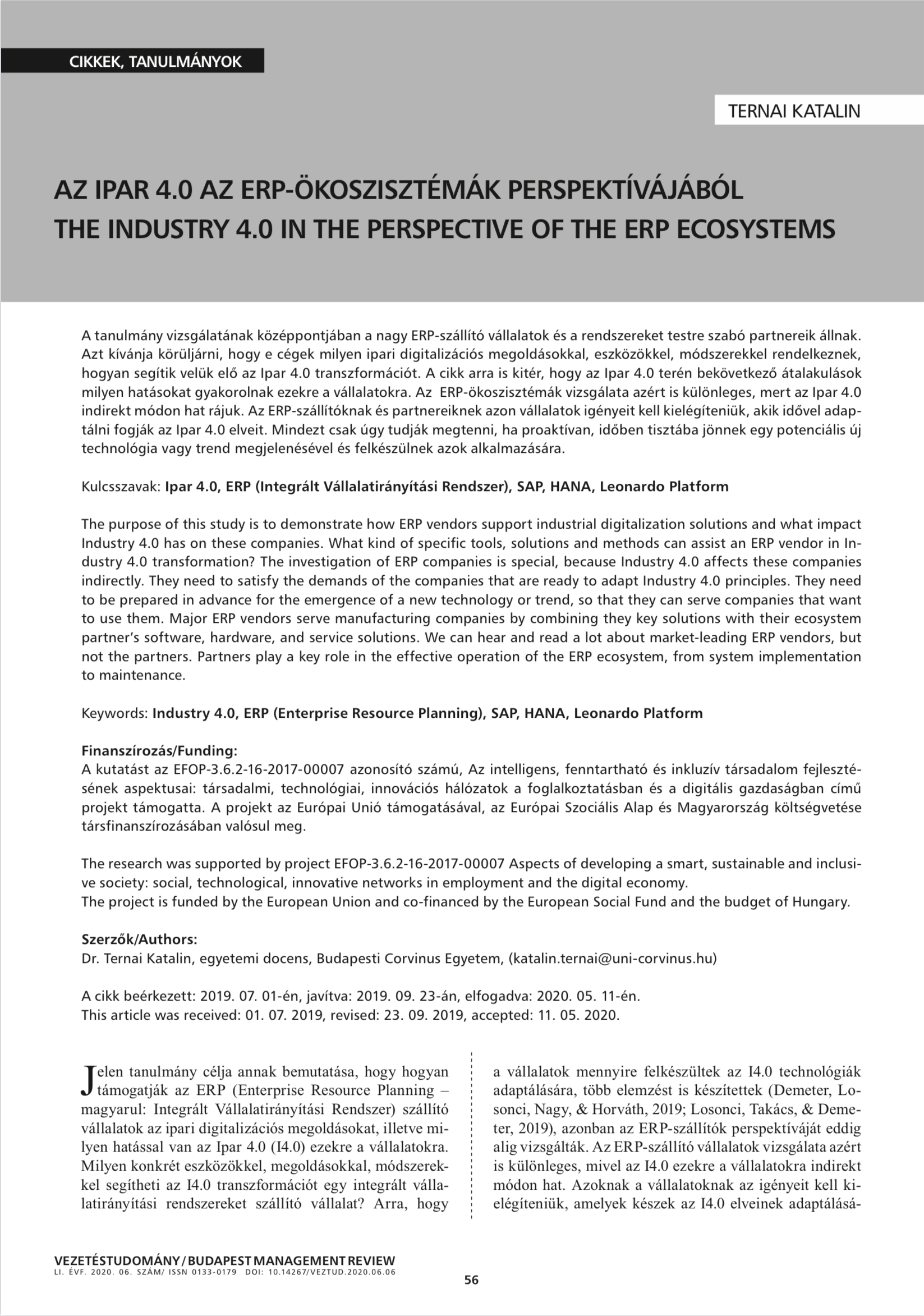Az ipar 4.0 az ERP-ökoszisztémák perspektívájából
DOI:
https://doi.org/10.14267/VEZTUD.2020.06.06Kulcsszavak:
Ipar 4.0, ERP (Integrált Vállalatirányítási Rendszer), SAP, HANA, Leonardo PlatformAbsztrakt
A tanulmány vizsgálatának középpontjában a nagy ERP-szállító vállalatok és a rendszereket testre szabó partnereik állnak. Azt kívánja körüljárni, hogy e cégek milyen ipari digitalizációs megoldásokkal, eszközökkel, módszerekkel rendelkeznek, hogyan segítik velük elő az Ipar 4.0 transzformációt. A cikk arra is kitér, hogy az Ipar 4.0 terén bekövetkező átalakulások milyen hatásokat gyakorolnak ezekre a vállalatokra. Az ERP-ökoszisztémák vizsgálata azért is különleges, mert az Ipar 4.0 indirekt módon hat rájuk. Az ERP-szállítóknak és partnereiknek azon vállalatok igényeit kell kielégíteniük, akik idővel adaptálni fogják az Ipar 4.0 elveit. Mindezt csak úgy tudják megtenni, ha proaktívan, időben tisztába jönnek egy potenciális új technológia vagy trend megjelenésével és felkészülnek azok alkalmazására.
Letöltések
Hivatkozások
Acatech (2013). Securing the future of German manufacturing industry, Recommendations for implementing the strategic initiative INDUSTRIE 4.0. Federal Ministry of Education and Research https://en.acatech.de/publication/recommendationsfor-implementing-the-strategic-initiative-industrie-4-0-final-report-of-the-industrie-4-0-working-group/
Autopro és SAP Hungary (2018). Nagyot kockáztatnak a magyar cégek. Retrieved from https://m2mzona.hu/auto/nagyot-kockaztatnak-a-magyar-cegek/amp
Basl, J. (2017). Pilot Study of Readiness of Czech Companies to Implement the Principles of Industry 4.0. Management and Production Engineering Review, 8(2), 3-8. Retrieved from https://journals.pan.pl/dlibra/show-content?id=106284&
Basl, J. (2016). Enteprise information systems and technologies in Czech companies from the perspective of trends in industry 4.0. Confenis Conference, Wien. https://hal.inria.fr/hal-01630542
Berger, R. (2014). Industry 4.0 The new industrial revolution (How Europe will succeed?) http://www.iberglobal.com/files/Roland_Berger_Industry.pdf
Borbásné Szabó, I. (2018). Informatikai megoldások a digitális transzformáció szolgálatában: SAP Leonardo. Előadás EFOP-3.6.1-16-2016-00013 Intelligens szakosodást szolgáló intézményi fejlesztések a Budapesti Corvinus Egyetem Székesfehérvári Campusán, Székesfehérvár.
Cearley, D., Walker, M., & Andrews, W. (2017). Top 10 Strategic Technology Trends for 2018: Intelligent Apps and Analytics. Gatner, Inc. Retrieved from https://www.gartner.com/doc/3811368?srcId=1-6595640781
CMSC Media (2019). SAP Unveils Blockchain Service n the Cloud. https://www.cms-connected.com/PromoNews/SAP-Debuts-New-Leonardo-Blockchainas-a-Service
Demeter, K, Losonci, D., Nagy, J., & Horváth, B. (2019). Tapasztalatok az Ipar 4.0-val – egy esetalapú elemzés. Vezetéstudomány, 50(4), 11-23. https://doi.org/10.14267/VEZTUD.2019.04.02
Eisert, R. (2014). Sind Mittelständler auf Industrie 4.0 vorbereitet? http://www.wiwo.de/unternehmen/mittelstand/ innovation-readinessindex-sind-mit telstaendler-auf indust r ie-4-0-vorbereitet/10853686.html.
Gilchriest, B. (2018). Design Thinking and Intelligent Technologies | SAP Leonardo, SAP News Center. https://news.sap.com/2018/08/design-thinking-intelligent-technologies.
Haddara, M., & Elragal, A. (2015). The Readiness of ERP Systems for the Factory of the Future. Procedia Computer Science, 64, 721–728. https://doi.org/10.1016/j.procs.2015.08.598
Hermann, M., Pentek, T., & Otto, B. (2016). Design Principles for Industrie 4.0 Scenarios. In 2016 49th Hawaii International Conference on System Sciences (HICSS) (pp. 3928-3937). Koloa, HI. https://doi.org/10.1109/HICSS.2016.488.
IFUA Horváth & Partners (2017). Ipar 4.0 megoldások 2017-ben. https://www.controllingportal.hu/ipar-4-0-megoldasok/
Invitech (2019). Internet of Things technológia. https://www.invitech.hu/iot/technologia
IT Services Hungary (2013). Mi az a „Big Data”? https://www.it-services.hu/hirek/mi-az-a-big-data/
Kenedy, S. (2015). Made in China (2025). Center for Strategic and International Studies. Retrieved from http://csis.org/publication/made-china-2025
Kis E. (2014). A big data előszobája. Computerworld. Retrieved from https://computerworld.hu/uzlet/a-bigdata-eloszobaja-149212.html
Kovács O. (2017). Az ipar 4.0 komplexitása – I. Közgazdasági Szemle, 64(7-8), 823-851. https://doi.org/10.18414/KSZ.2017.7-8.823
KPMG (2016). The factory of the future. Retrieved from https://assets.kpmg/content/dam/kpmg/es/pdf/2017/06/the-factory-of-the-future.pdf
Losonci, D., Takács, O., & Demeter, K. (2019). Az Ipar 4.0 hatásainak nyomában – a magyarországi járműipar elemzése. Közgazdasági Szemle, 66(2), 185-218. https://doi.org/10.18414/KSZ.2019.2.185
MESSE (2019). Retrieved from https://www.hannovermesse.de/en/supporting-program/eventprogram/conferences
Monostori, L. (2014). Cyber-physical production systems: Roots, expectations and R&D challenges. Procedia CIRP, 17, 9-13. https://doi.org/10.1016/j.procir.2014.03.115
Nagy, J. (2019). Az Ipar 4.0 fogalma és kritikus kérdései – vállalati interjúk alapján. Vezetéstudomány, 50(1), 14-26. https://doi.org/10.14267/VEZTUD.2019.01.02
Németi R. & Berczik M. (2015). SAP HANA, mint az innováció záloga (Előadás). Budapest: Simonyi Konferencia.
Porter, M. E., & Heppelmann, J. E. (2014). How Smart, Connected Products are Transforming Competition. Harvard Business Review, 92(11), 64–88. Retrieved from. https://hbr.org/2014/11/how-smart-connectedproducts-are-transforming-competition
PwC (2016). Industry 4.0 – Building the digital enterprise. PriceWaterhouseCoopers LLP. Retrieved from https://www.pwc.com/gx/en/industries/industries-4.0/landing-page/industry-4.0-building-your-digitalenterprise-april-2016.pdf
Rouse, M. (2016). Definition: SAP Analytics Cloud. TechTarget. Retrieved from https://searchsap.techtarget.com/definition/SAP-Cloud-for-Analytics,
Rüßmann, M., Lorenz, M., Gerbert, P., Waldner, M., Justus, J., Engel, P., & Harnisch, M. (2015). Industry 4.0. The Future of Productivity and Growth in Manufacturing. Retrieved from https://www.bcg.com/publications/2015/engineered_products_project_business_industry_4_future_productivity_growth_manufacturing_industries.aspx#chapter2_section7
SAP (2019a). SAP Leonardo Intelligent Technologies. Retrieved from. https://www.sap.com/products/leonardo.html
SAP (2019b). The Intelligent Enterprise. Retrieved from.
https://www.sap.com/products/intelligent-enterprise.html
SAP Help Portal (2019). Installation Guide for SAP Data Hub. Retrieved from https://help.sap.com/doc/922191c241c74d00bcbc3efaa06f8606/2.4.latest/en-US/loio922191c241c74d00bcbc3efaa06f8606.pdf
SAP (2019c). Data Management. Retrieved from. https://www.sap.com/products/technology-platforms/datamanagement.html
SAP (2019d). SAP Data Hub. Retrieved from. https://developers.sap.com/topics/data-hub.html
Szeker V. (2018). ERP vállalatok felkészültsége az Ipar 4.0 támogatására (TDK-dolgozat). BCE. Gazdálkodástudományi kar. Gazdaságinformatika, Budapest.
Szeker V. (2019). Az Ipar 4.0 hatása a magyar iparvállalatokra és az ERP szállító cégekre (Szakdolgozat). BCE. Gazdálkodástudományi kar. Gazdaságinformatika, Budapest.
Ternai K. (2003). Az ERP-rendszerek metamorfózisa. Vezetéstudomány, 34(7-8.), 35-38.
Tulusan, J., & Hidvégi, P. (2017). SAP Leonardo Digital Manufacturing: Important Steps, Partners, Project, Hungary. In Industry 4.0 Workshop, 20th September 2017, Budapest.
Yin, R. K. (2012). Applications of Case Study Research (3rd edition). Thousand Oaks: Sage.
Wang, S., Wan, J., Li, D., & Zhang, C. (2016). Implementing smart factory of industrie 4.0: an outlook. International Journal of Distributed Sensor Networks, 12(1). Retrieved from https://journals.sagepub.com/doi/10.1155/2016/3159805

Downloads
Megjelent
Hogyan kell idézni
Folyóirat szám
Rovat
License
Authors assign copyright to Vezetéstudomány / Budapest Management Review. Authors are responsible for permission to reproduce copyright material from other sources.

